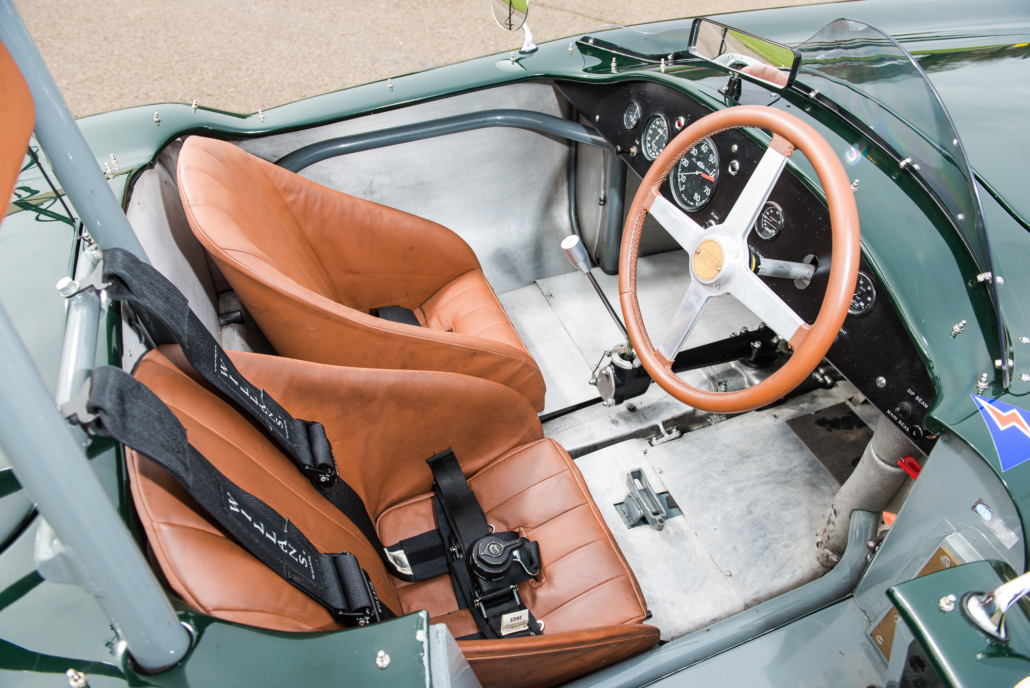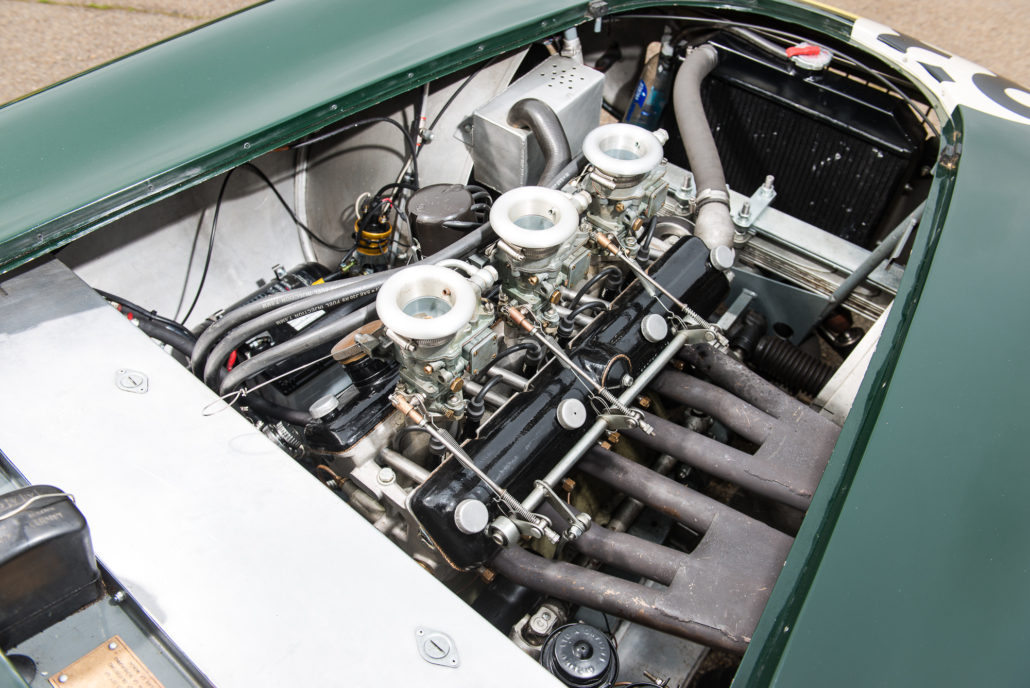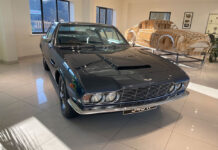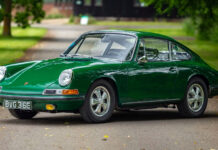Pendine is offering this Cooper Bristol for sale. Driven by Juan Manuel Fangio at Goodwood.

- Driven by Juan Manuel Fangio at Goodwood
- The first Cooper to ever score World Championship points
- Extensively raced as a single seater in 1952 including at Goodwood, Silverstone, Spa, Monza and Buenos Aires
- One of three Barchetta Cooper Bristol sports car built and raced in 1954
- Competed at Goodwood as a sports car, Easter 1955 and internationally at the Bol d’Or Internationales, a 24-hour race held at Montlhéry
- Restored to its sports car specification by Cooper Bristol specialists IN Racing
When Formula 2 was awarded World Championship status, the hunt was on to find suitable race cars in which to compete. There were many motor racing enthusiasts, often running pre-war machinery or sports cars on a budget, who had thought they’d never be able to contend a Grand Prix car at an international level. Charles and John Cooper, who had been successfully building their fabulous little 500cc single seater in Surbiton, saw the demand, and filled the void. Utilising what they considered the best engine of the day, the 2-litre, straight-six built by the Bristol Aviation Company’s car division, they developed their successful 500 chassis into something far more substantial.
Launched in January 1952, the Cooper T20 – or Cooper Bristol Mk1 as it is more commonly known – was the go-to racer by the small, professional race teams to showcase their talented young drivers.
CB/2/52
The first buyer, before the chassis and engine had even been publicly announced, was Alan Brown under the banner of Ecurie Richmond. Additionally, Ecurie Richmond team proprietor Jimmy Richmond bought a second MkI to be piloted by Eric Brandon. These were chassis numbers CB/2/52 and CB/3/52. Both were painted light metallic green with coloured nose bands, Brown’s (CB/2/52) in dark blue and Brandon’s with deep red.
Both made their debut as part of a quartet of Cooper-Bristols at the Goodwood Easter Monday meeting (inlcuding the little known talent Mike Hawthorn in a third Mk1). Fangio happened to be there competing that weekend in the V16 BRM. Fascinated by the new Cooper, he ended up racing in CB/2/52 for the Chichester Cup, but was troubled in the race by the brakes.
It was a near perfect debut for the new Cooper; Hawthorn stole the headlines by winning both the Lavant Cup and the Formula Libre Chichester Cup, with Brown behind him in second, and then winning the Handicap race. Brown and CB/2/52, knowing that to keep their names in the headlines they had to keep ahead of Hawthorn and his gang, made history on May 18th by scoring Cooper’s very first World Championship points, finishing fifth in the Swiss GP. The following month Ecurie Richmond contested the Belgium GP, along with Hawthorn in the Chase car, Brown brought home CB/2/52 in sixth, two places behind Hawthorn.
There was an engine failure at Reims, and a troubled finish at the Silverstone Grand Prix. The next month saw the Ecurie Richmond team finish behind Hawthorn in the pouring rain at Boreham in a combined F1/F2 race, followed with races at La Baule, Grenzlandring and Monza, with a third at the last Goodwood meet a welcome result. CB/2/52’s debut season ended during the years last race at Castle Combe where Alan tangled with John Barber, without harm to either driver, but the Cooper-Bristol wasn’t improved by the encounter. Season over, CB/02/52 was retired by Brown.
At the end of 1952, Alan Brown left Ecurie Richmond and joined Hawthorn backer Bob Chase’s team. The ’52 Hawthorn Cooper Bristol, now redundant due to the arrival of the Cooper Bristol MkII, was rebuilt into a sports racing car. Built by Bernie Rodger and re-bodied by Wakefields of Byfleet, it resembled a Ferrari Barchetta and was registered HPN 665. Under the auspices of Equipe Anglaise, it became a regular at British club meetings throughout the year. Brown then decided that CB/2/52 was to be given the same treatment, again with a body from Wakefields. Registered UPF 440, it was sold in early 1954 to eccentric West Country used car salesman David Watts, who during his brief ownership set a new hillclimb record in Cornwall at Trengwainton before selling it on to Tom Kyffin.
Tom’s new team, Equipe Devone, competed throughout 1954 at events including Snetterton and Crystal Palace, as well as more local tracks such as Castle Combe and Davidstow, scoring two third places at the latter. Presented in British Racing Green with a yellow and grey nose- band, matching yellow Cooper wheels and yellow band around the radiator opening, the unusually well turned out for a privateer at the time. Next was the Easter Monday Goodwood meeting in April with Kyffin finishing 8th. In May 1955 Kyffin, together with co-driver Halford, entered the Bol d’Or Internationales, a 24-hour race held at Montlhéry. The circuit’s rough surface caused the spare wheel – which was next to the fuel tank in the back – to break free, taking some of the bodywork with it, and thus a retirement.
Back in Devon and repaired, further races included a podium at Davidstow, before being put up for sale.
In 1959, UPF 440 was bought by Aubrey Taylor, who probably only used it as a road car, along with subsequent owners Eric Castle and Harry Pattison. The late Stephen Curtis, a well-known historic enthusiast, paid £320 to Pattison and was soon using the sports car in races, sprints and hillclimbs. Once again, CB/2/53 was at a seminal motor sport event when piloted by Curtis, it formed part of the inaugural grid of the Griffiths Formula race at Castle Combe on May 14, 1966, an event that was effectively the start of historic racing and would eventually lead to the formation of the Historic Sports Car Club.
Because of the increasing number of suitable races, such as the JCB series, next owner John Roberts removed the Barchetta body from the chassis over the winter of 1969/1970. Roberts then raced the now single seat F2 Cooper- Bristol for three years in the burgeoning historic movement. Before long the Cooper-Bristol was a regular on the historic racing scene and in 1984 it moved to the other side of the world to Dunedin, New Zealand and the garage of Wayne Marsh. He would race the single seater for ten years before its return to the UK and the London showrooms of Gregor Fisken. Fisken sold it to Michael Fraser in 1994, who along with his son Max, continued to race the car in historic events. By this point, CB/2/52 was being looked after by Ian Nuthall Racing and following an accident at a VSCC meeting, IN Racing undertook the repairs, which were mainly confined to three of the four corners. During the rebuild it was observed that the chassis was, despite leading a full and active life, in remarkably original condition.
Ian Nuthall bought the car mid restoration, completed it in 2009, and sold it to property surveyor Nick Eden who continued to use INR to run CB/2/52 for him with the now well-established Historic Grand Prix Cars Association. Eden and CB/2/52 were an impressive duo, with success at historic events such as the Goodwood Revival and Monaco. Unfortunately their racing partnership ended abruptly in the summer of 2014 in Germany at the Old Timer Historic meeting at the Nürburgring following an accident.
The Cooper-Bristol was taken back to IN Racing for damage assessment. Chris Phillips, a long-time customer of Nuthall and owner of a Cooper Bristol MkII (CB/6/53), had been looking for a sports racer to compete alongside the single seater. By coincidence, Cooper-Bristol aficionado Roddy MacPherson had drawn IN Racing’s attention to an advert in Classic & Sports Car magazine for a Cooper-MG. Having followed this Cooper-MG for decades, Nuthall knew that the car featured the original Barchetta body off UPF 440. Nuthall and Phillips devised a plan to buy the Cooper-MG and for the second time, convert the single seater chassis into a sports-racer.
The backstory to the Cooper-MG is simple enough. After Roberts had returned UPF 440 to a single seater in the 60s, the Barchetta body had been put on a Cooper-MG chassis , finding its way via an advert in Autosport to American enthusiast Anatoly Arutunoff, Oklahoma. The Cooper-MG would form part of Toly’s collection for well over 20 years, finally letting it go in 1994. It was raced during this period, including at the 1984 Vintage Bahamas Speedweek meeting. Bought by respected Floridian collector Howard Banazak Jr, he had the car restored and it was from Banazak that Phillips acquired the original Wakefield bodied Cooper-MG in 2015. Both the chassis and body from the Equipe Devone sports car were finally re-united at Nuthall’s Nottinghamshire workshop and the restoration begun.
Its first outing was at the Silverstone Classic in 2016, in the Woodcote Trophy, driven by Chris Phillips and his son Oliver. This was followed by that year’s Goodwood Revival, coming home 9th in a very wet Lavant Cup. Unquestionably, the highlight of the weekend was the gathering of three of the sports car bodied Cooper-Bristols; UPF 440 was joined by the first of the Alan Brown sports cars, the ex-Hawthorn Mark I Cooper-Bristol registered HPN 665 and UPA 261, the works first ‘production’ model. Since then, Phillips has sparingly raced UPF 440 in high profile historic events at the likes of Donington and Silverstone.
One of the most forensically documented and researched historic racing cars Pendine has come across, it is accompanied by file upon file of documentation. Prepared to an exceptionally high level by IN Racing, CB/2/52 is hugely eligible. Current HTP papers class is as a T22/25, with the T25 being eligible for the Mille Miglia. With Fangio, Goodwood and international race history as both a single seater and sports car, this historic Cooper is now available in its current sports car form for the first time in over 50 years.
Click here for further information
collectorscarworld is partnering with the most renowned classic car specialists and dealer-ships in the world. We always offer selected rare and sought-after collectors cars and supercars for sale and every day a special car is featured for one of our partners. The passion for classic cars is diverse, sometimes it concerns the beauty of forms that can be admired at a concours, sometimes it is the smell of rubber , old leather and gasoline at a racing event or trip in the sunset.
Or its a classic car you have great memories with or which your parents owned a longtime ago. Classic cars and supercars are an expression of the lifestyle that someone shares with other petrolheads, and which is immortal, enduring and always a lot of fun. If you are looking for a special car or need support in the evaluation and history of cars, please contact us at info@collectorscarworld.com


Interested in further “cars for sale”? Click here.















